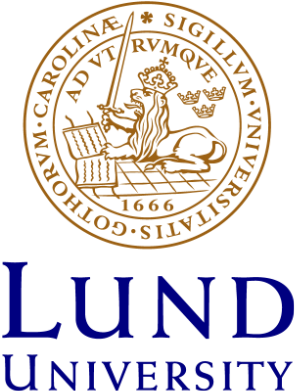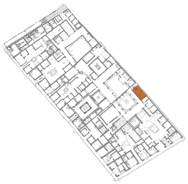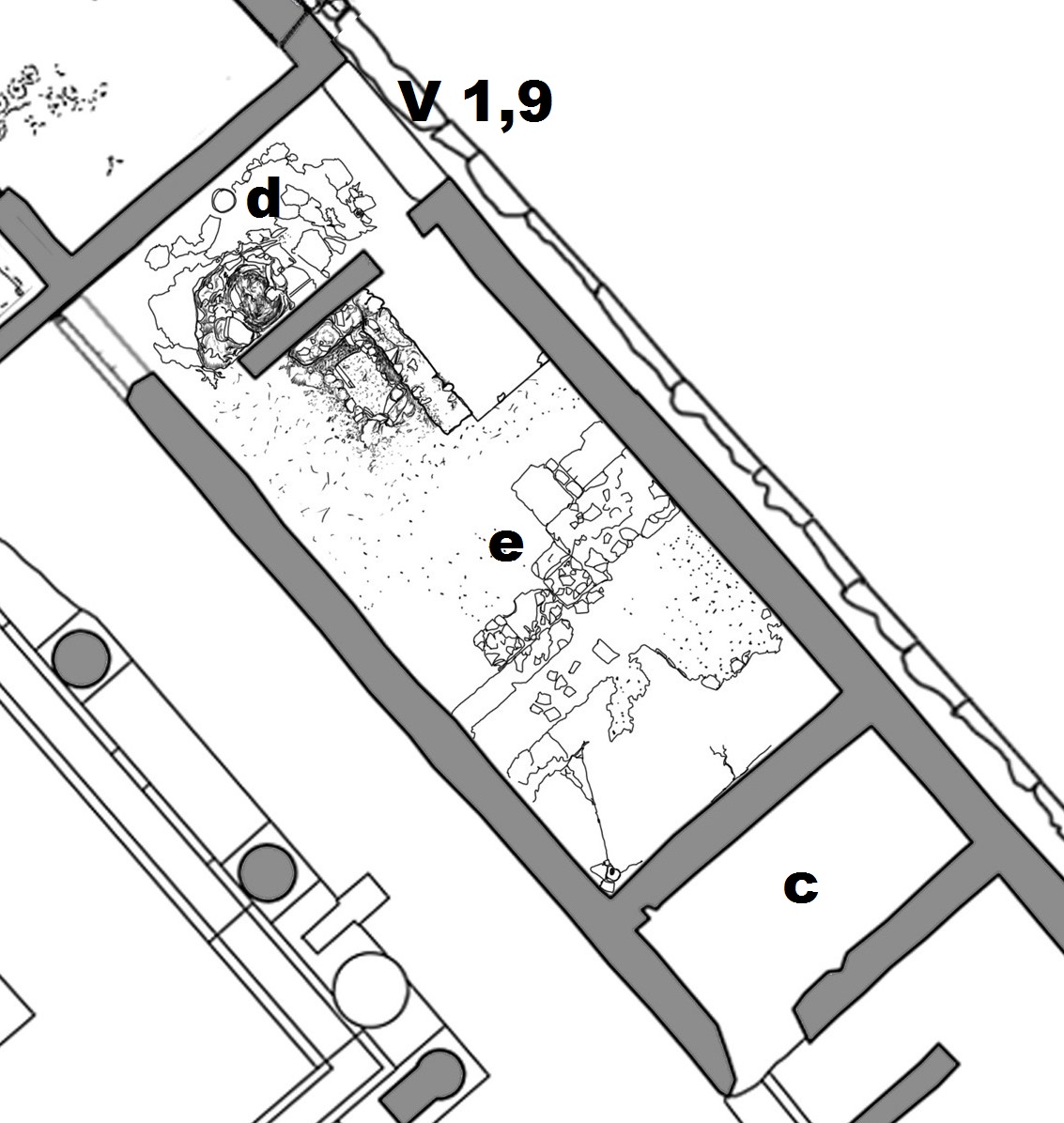Room e
Description
Thomas Staub
Dimensions: 3.35 x 6.70 m = 22.45 m²
Room e is situated in the eastern part of the house, its east wall forming the east facade of the house towards the Vicoletto di Caecilio Iucundo. This wall as well as the north wall seems more or less unchanged, in the north wall only the two dooropenings towards posticumd could be a later addition. The south wall shows a very mixed opus incertum, probably that wall was erected in a later phase. Two arched doorways, which earlier opened up towards the south were closed off in an even later stage, as well as a round window in the upper central part of the wall. Also the west wall show a more mixed incertum, but several frames of later blocked off doors towards the peristyle constructed with larger blocks of sarno stone could indicate, that this wall is at least partly original with some repairs.
When starting the investigations in this room it was filled with a ca. 0.50 m high layer of debris, remains of modern burnt garden garbage and parts of the fallen down roof and floor from the upper storey. In some parts, especially in the middle and northern parts of the room, the floor surface was too damaged to define, whereas it is well preserved in its southern part. Different structures in the floor indicate that this space, now named room e, was partitioned into several rooms, probably by walls in timber framing technique, of which only traces of the founding can be detected at some places at floor level.
In this room some remains of masonry features indicate its use for some kind of manufacturing or production. In the northeastern corner, a small cubicle was separated from the remaining room by walls in opus cratitium, of which only the remains of the foundation are preserved today (This quite cheap and easy-to-use building technique, consisting of a wooden framework filled with either reed work and clay or opus incertum, was used mainly for non-bearing walls. It was partly preserved in the Casa di Iulius Polybius (IX 13,1-3), room y, where it can be seen in a reconstructed version). This cubicle, accessible from the north, through the easternmost doorway from posticumd contained the latrina of the house, with the cesspit reaching under the dividing wall into the posticum. To the west of the toilet, a basin, 0.7 m x 0.42 m, was also connected to the cesspit. Further to the south are remains of a working bench, partly covered by attached roof tiles. It extends in an east-west direction and is preserved in the eastern part of the room. A drainage hole in the southwestern corner of the room, inserted into the quite well preserved cocciopesto floor and leading towards the back street of the insula, indicates the use of water in this room (Why this drainage was placed in that corner and not in the southeastern one, next to the back street, remains a question. It would certainly have been much easier to place it there, instead of having to construct a drainage channel underneath the floor. On drainage holes in Pompeian kitchens for leading away water used for cleaning it, see Salza Prima Ricotti 1980, 244-246). Even here, remains and traces of an earlier layout of the room show that it had been totally restructured sometime during the life span of the house, but again there are no details preserved which allow a dating of this change.
In the original building lay-out rooms 12, c and the southern part of room e probably formed one larger room, maybe functioning as a triclinium, with a door opening up at the northern end of its west wall towards the peristyle (6.0 m x 3.35 m). The lower parts of the door frames, made of blocks of Sarno stone and apparently placed both as standers and as stretchers are still visible in the southern part of the west wall of room e (the peristyle - side of this wall ( i.e., the east wall of the peristyle) is so thickly covered by modern concrete that no accurate observation is possible from that side). Remains of wall plaster, which originally covered the inner sides of these door frames (i.e., towards the later, closed-up door opening) can still be observed from room e continuing into the later wall. While cleaning the floor in room e, remains of the former dividing wall between this room and the smaller one to the north were detected. The wall was turned down in a later phase and preserved to a height of 0.05 m, and the remains were partly, as it seems, integrated in a later working bench or some other structure. To the north of this wall a second, smaller doorway seems to have opened up between this northern room and the peristyle. Also, the frames of this door were constructed of Sarno stone blocks, which are mainly visible in the east wall of room e. Here as well the wall plaster covering these frames is visible on the stone blocks, covered by the later incertum used for the sealing up of the door. Whether this smaller room in the northern part of the later room e also opened up towards the posticumd already in the original phase of the house is difficult to decide.
In the Iulio-Claudian rebuilding phase probably the older dividing wall, which had created two rooms, was pulled down, forming the larger room e, and the supposed doors towards the peristyle were blocked off.
The door or doors between rooms c and e and the small window were probably blocked in an even later stage in the life of the house, when room e was rearranged. As the latrine, placed in room c of V 1,3 was now no longer easily accessible after the closing off of the door in the kitchen area, a new latrine was installed in the northeastern corner of room e. At this period, the western door between room e and posticumd was also opened up, giving access to the area west and south of the latrine.
This part of the house was probably excavated sometimes between 1876 and 1878, not documented.
Dimensions: 3.35 x 6.70 m = 22.45 m²


